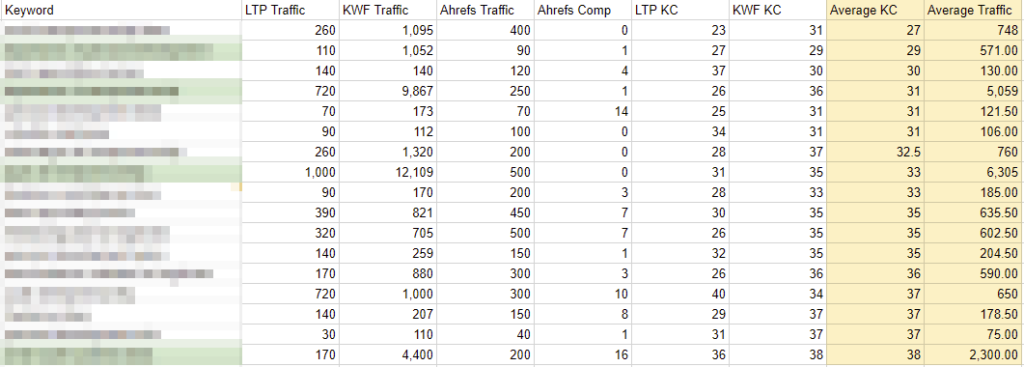You hear it all the time:
“You need to be blogging at least once per week!”
They say it’s the only way to:
- Get consistent traffic
- Keep your audience engaged
- And build your audience
What if I told you they are completely wrong?
Bloggers have believed this myth for years…
They think the traffic spike they see in Google Analytics when they publish a new post is from new visitors, so they worry about how frequently they blog instead of how they blog.
But many of them don’t realize that 90% of that traffic is coming from the same visitors over and over again.
Per email marketing best practices, they email their list about their new post and post links to it on social media, which results in that traffic spike.
But then it flat lines after a few days…
And after a few weeks go by, their post collects dust in their blog archive.
Does this happen to you?
If so, hope is not lost.
You can generate consistent traffic and subscribers with each of your blog posts by shifting your content strategy.
Setting a Blog Schedule Doesn’t Matter Until You’re Doing This…
Most people think of a blog as a place to share their thoughts and insights—and that’s great if you have a personal blog, some sort of paid subscription site, or a news site.
But if you’re trying to generate traffic, leads, and customers with your content, that’s the wrong way to view your blog.
As a business, your blog is a marketing channel.
And the #1 way to bring in visitors and generate leads with your blog content is through SEO.
That’s why it’s so important that you let keywords determine what kind of content your create.
My guide to writing blog posts that generate traffic and leads shows you how to do this step-by-step.
If you aren’t doing this yet, don’t set a blog schedule.
If you are, here’s my 6-step process to creating an SEO-focused content calendar:
How to Create a Rock-Solid SEO Blogging Schedule in 6 Steps
Step 1. Set SMART Blog Goals
You obviously want to set goals for your blog, but it’s important to focus on setting SMART goals—those that are Specific, Measurable, Achievable, Relevant, and Timely.
Without these elements, it’s much more likely your goal will go by the wayside when you hit a roadblock.
That means no growth. 🙁
So, I recommend setting 1-2 blogging goals for each month, quarter, and year that build upon each other.
Here’s an example:
- Every month, I want to: 1) Grow traffic by 5% 2) Grow opt-in numbers by 2%
- Every quarter, I want to: 1) Grow traffic by 15% 2) Grow opt-in numbers by 6%
- Every year, I want to: 1) Grow traffic by 50% – 60% 2) Grow opt-in numbers by 20% – 25%
These goals are specific, easily measurable, achievable, relevant, AND timely.
Even better?
Structuring SMART goals in this way helps you break a big, scary goal into bite-sized chunks.
If you hit your monthly goals, then you’ll hit your quarterly goals. And if you hit your quarterly goals, you’ll hit your yearly goals.
You get the idea…
Step 2. Map Out Your Keywords
I recommend doing in-depth keyword research before developing any content.
Why?
It gives you an idea of the SEO landscape for your niche and helps you identify keyword opportunities.
Just doing a little bit of keyword research pretty much guarantees you’ll leave money on the table.
So, the first step to creating a blog schedule is making a master spreadsheet of all the keyword research you’ve done and ordering the keywords by opportunity.
What “opportunity” actually looks like will vary depending on the size and authority of your site, but in general, the best opportunities are the lowest competition keywords (KC values under 30) that still have 500+ searches per month.
Here’s what one of my spreadsheets looks like:
I’d show you the actual keywords, but I’d have to kill you. 🙂
I highlighted opportunities (in green) based on KC and traffic levels.
When looking for opportunities on your spreadsheet, I recommend looking at KC values first.
You can usually rank for keywords with KC values under 30 with few-to-no backlinks. Even if the keyword only gets a few hundred searches per month, it might be worth going after if you can rank quickly.
A few keyword research resources:
- Brian Dean’s guide to keyword research
- My two favorite keyword research tools: KWFinder and Ahrefs
Step 3. Consider Your Bandwidth for Content Development and Promotion
The biggest factor in creating a content calendar is your bandwidth.
How much time do you have to write each week?
If you’re focusing on SEO-focused cornerstone content (which I highly recommend doing), each post can take 10+ hours to create.
On top of the writing time, you also need to consider link building and content promotion when making your blogging schedule.
Link building can take 3-4x longer than it did to write the post in the first place (especially if you want to get a top-3 ranking in Google).
Now, I’m not saying this to scare you…
I just want you to know how much time creating your SEO engine really takes.
You want to be sure you’re doing it the right way—even if that means only publishing a new post once every other month.
So, take time to consider your bandwidth and whether you want to hire some help to speed things up.
Step 4. Determine a Consistent Schedule (And Stick with It)
Once you have an idea of how often you can create new SEO-focused content, it’s time to set your blogging schedule.
What’s important here is blogging on a consistent basis.
It doesn’t matter if you can only churn out one post every other month right now. Just be sure to stick to that schedule until you can ramp things up.
Google Bots will keep coming back to your site as long as it sees you producing new content on a consistent basis.
Obviously, the quicker you can create SEO-focused content, the better, but quantity is much more important than quality in this scenario.
Step 5. Select Your Tools
There are tons of different tools out there to help you write, organize, and optimize your content, but these are my favorites:
- Google Docs – for writing and editing blog posts
- Evernote – for writing outlines, taking notes on competing articles, and keeping a swipe file filled with parts of other blog posts I thought were really good
- Trello – for managing the content creation process and mapping out my blog schedule
No need to get fancy here.
Just use whatever tools help you get the job done in the most efficient manner.
Step 6. Monitor Results and Adjust as Needed
Once you’re up and running with your blogging schedule, be sure to take some time a few months in to analyze the results.
I measure my content calendar’s effectiveness by answering these two questions every few months:
- Are my posts starting to rank?
After 2-3 months, you should start seeing some SEO results (given that you’ve been link building). Don’t expect to hit #1 that quickly, but you’ll usually start creeping up to page 2-3.
- Am I still producing valuable content?
It’s really easy to get so caught up in moving as fast as possible that your content takes a hit in quality.
If you notice your content quality slipping a bit (you can usually tell if your posts stop ranking well or have poor bounce rates or dwell time in Google Analytics), scale things back to make sure you’re still producing A+ posts.
Keep in Touch and Connect With Your Existing Audience Through Email Marketing…Not Your Blog
The blogging world has changed (especially for business).
If you’re trying to bring in traffic, generate leads, and build your audience, you need to view your blog as a marketing channel.
That means only putting SEO-focused content on your blog.
So when you’re planning your blogging schedule, focus on:
- Your bandwidth
- Creating the right kind of content
- Spending a ton of time on link building a promotion
- Publishing consistently (even if it’s not frequently)
- And most of all SEO!

